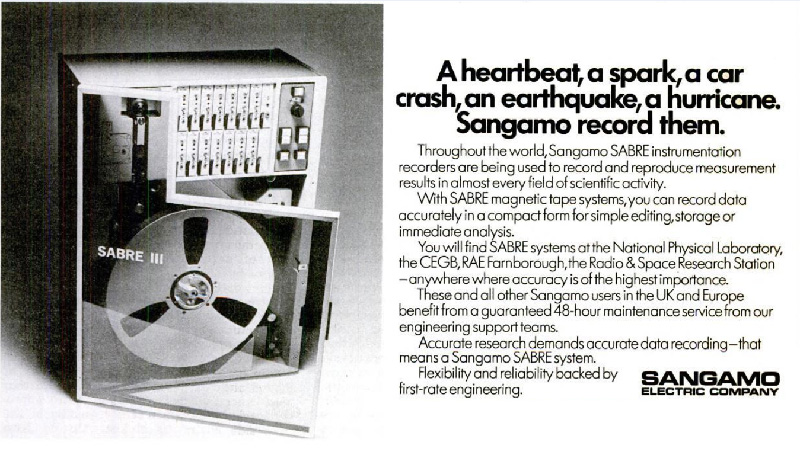This will make for a long post as I keep adding more information in time. That’s because the use cases of an instrumentation recorder/reproducer are quite plenty. Recording and reproducing of signal data is still made today in many fields, but since mid 80’s the digital format (flash memory, SSD drives) begun to replace magnetic tapes and other analog mediums. In short, what an old instrumentation machine similar with the Sabre was doing in the 60’s-70’s, is still made today, but on digital.

A magnetic tape player that is used for listening music or voice recordings is built different than instrumentation ones. In short, the later is specifically made to record/reproduce signals of various voltages and frequencies, and most of the time on many tracks (multitrack), aimed to aid research in various fields. As these require precise data having little or no error, specialty (often military-grade) mechanisms and electronics are employed.
However, on the creative side, this is where things can get interesting… Curious enough people that don’t sleep well at night (to be read doing creative stuff when others are sleeping), are crossing the barrier between consumer apparel and laboratory/test equipment, and so they create art (music prominently), various projects or just funny experiments using such equipment. Guessing an instrumentation recorder/reproducer could be used for such things? Well I might have some surprises down the line, so stay close with this journey.
Before continuing on use cases, let’s see what actually a tape recorder/player (reproducer) is. I consider best this excerpt (NASA Reference Publication 1075, April 1982 – Magnetic Tape Recording for the Eighties):
The magnetic tape recorder/player (reproducer) is a complex electromechanical system. It involves, basically, a magnetic tape on reels or cassettes; tape drives; magnetic heads for erasing, recording, and reproducing; and associated electronics. These subsystems must be precise, durable, and maintainable. The tape drive must be precise to maintain the proper tension in the magnetic tape to minimize tape flutter and other mechanical distortions of the tape, which distort the recording and/or damage the tape. The magnetic recording and playback heads must be precise and accurately aligned to permit recording on one machine and undistorted playback on another.
That being said, data recorded with such a machine come from sensors that measure electrical data, like voltage and current, or physical data, such as temperature, radiation and pressure. As these sensors capture signals in many forms, and because instrumentation recorders can only process electrical signals, the non-electrical source information is converted to an electrical form prior to be recorded on the tape. The data will then be analyzed to gain scientific insights on the respective recorded events.
Now with a basic idea of what these machines are and a brief description of what signals they process, let’s begin with their in-detail use cases. For this I’m going to handpick areas where either specifically the Sabre III or other Sangamo machines were used to record data, either on the field, on a lab, airborne or underwater (maybe in space too?)
NASA
CERN / Physics
US army / USDOD
Commercial planes
Telecommunications
Energy
Meteorology
Medicine
Automotive
Work in progress as of 25 May 2023…